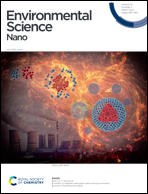Fate, uptake and gut toxicity of two colloidal silver products in mice: how micro X-ray fluorescence, micro X-ray absorption spectroscopy and near-infrared spectroscopy provide new insights in food nanotoxicology†
Abstract
Silver biodistribution and gut toxicity of two commercially available colloidal silver products, Mesosilver™ and AgC, were evaluated in male mice. AgC is composed solely of ionic silver (Ag+) while Mesosilver™ contains a mix of silver nanoparticles (AgNPs) and Ag+ ions. After high-dose (approximately 3 mg per kg body weight (bw) per day) sub-chronic exposure, silver accumulation was close for Mesosilver™ and AgC. The combination of micro X-ray fluorescence and micro X-ray absorption spectroscopy showed that metallic AgNPs and Ag+ ions initially contained in Mesosilver™ were subjected to physicochemical modifications during their fate in the gut. In the colon, most Ag atoms were oxidized and dissolved to form Ag complexes with thiol groups (–SH) of proteins and/or peptides. Sub-chronic exposure at lower dose (150 μg per kg bw per day) led to a moderate impact on the gut barrier for both colloidal silver products. An increase in colonic LCN-2 was observed only after AgC exposure. For gut microbiota at the genus level, exposure to Mesosilver™ led to a decrease in Ruminococcus and Anaerosporobacter, while Intestinimonas increased. Exposure to AgC resulted in an increase in Clostridium sp. ASF356 and Tyzzerella, while the relative abundance of Anaerosporobacter decreased. In addition, the Saccharomycetes fungal population increased. Near-infrared spectroscopy was able to satisfactorily discriminate the Mesosilver™- vs. AgC-exposed mice for both exposure doses. This study highlights the applicability of biophysics-based methodologies for providing novel insights into colloidal silver uptake, fate and toxicological effects after oral exposure.



 Please wait while we load your content...
Please wait while we load your content...